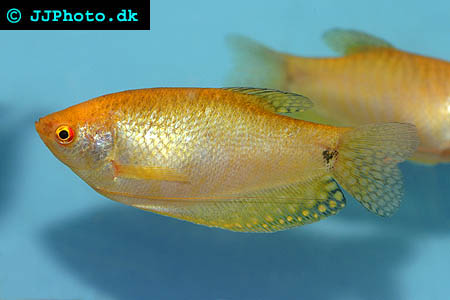Gourami Breeding
Gourami species are usually comparatively easy to breed in aquariums. All Gourami species are egg-layers, and several species are renowned for building very beautiful bubble-nests in which they keep egg and fry. If you want to try breeding one of the bubble-nest Gourami species, the Colisa Lalia (Dwarf Gourami) is a very good choice for beginners. Remember that the bubble nests are very sensitive and can be ruined by water movement. Keep all water movement to an absolute minimum while you have a bubble nest in your aquarium. The guidelines offered in this article is true not only for Colisa Lalia but for many other Gourami species as well. It is however always a good idea to also check breeding information regarding the specific Gourami species that you wish to breed, to make sure that its requirements are not different from most Gouramis.
Firstly, breeding Gourami will require the set up of a separate breeding aquarium. This aquarium does not have to be very high or large; a height of six inches and room for 10-20 gallons of water is quite enough. Cover the bottom of the aquarium with a thin layer of gravel and place a small foam filter in one of the corners. Do not use any type of filtering that produces strong water currents if your Gourami species is a bubble-nest builder. Since the male Gourami can be quite a pest for the female Gourami, you will need to provide her with good hiding places in the breeding aquarium to reduce stress and stay out of harms way. Live plants are advisable and other sheltering aquarium decorations, such as clay pots, are also very good hiding spaces for a female Gourami. Java moss is a hardy plant that is often used in Gourami breeding aquariums.
A male Gourami will always claim a territory and fiercely defend it. It is therefore recommended to place the female Gourami in the breeding aquarium first. Give the female Gourami a few weeks to get accustomed to her new home before your introduce the male Gourami. It is advisable to wait until the female is evidently gravid before you introduce the male. The diet is important if your want your female Gourami to become gravid, and she should ideally be fed meaty foods such as blood worms and brine shrimp. Keep the lighting in the breeding aquarium subdue. The water temperatures should be kept in the 25-28 degrees C range and the pH between 6.6 and 7.6.
Once the male Gourami has been placed in the breeding aquarium the female will commence her bubble nest building, if your Gouramis are bubble-nest breeders. Regardless of Gourami species, the female and male Gourami will start dancing with each other. Soon you will be able to see how the male Gourami cups the body of the female Gourami and wiggle close to her. Finally the female Gourami will release her eggs and the male will fertilize them. The eggs will be safely placed inside the bubble-nest. This behaviour will be repeated a number of times and after several hours the female Gourami will have deposited more than 600 eggs. When you notice that the process is over you should remove both parents from the aquarium. Be very vigilant not to disturb the bubble-nest when you remove the parents from the aquarium.

Gold Gourami is an easy species to breed. Copyright www.jjphoto.dk
Now is time to turn of the filter completely in the breeding aquarium. Using a siphon you should remove water from the breeding aquarium until it is half empty. Use a small siphon and be extremely careful, otherwise you might harm the bubble-nest. Low water pressure and warm temperatures are beneficial to the offspring, and the breeding aquarium should be covered. If you keep the offspring in a breeding aquarium where the water pressure is too high or where the temperatures are too low, the young Gourami will not develop perfect labyrinth organs. After less than 24 yours the Gourami eggs will hatch and after 3-5 days you can see free swimming fry in the breeding aquarium. Feed the Gourami fry newly hatched brine shrimp or liquid fry food. It is imperative to keep the water quality superb, and any dead fry or excess food must be removed. Larger fry will commonly attach smaller fry. When the surviving fry are ½ inch long you can place them in the community aquarium with the parents and other fish. Don’t loose your enthusiasm if you end up with no surviving fry at all during the first spawning. Sometimes it takes a few tries to get everything right. If you keep detailed records of water temperature, feeding procedures etcetera it will be easy for you to adjust things that do not work out well.
Didn't find the info you were looking for? Register for free and ask your question in our Aquarium forum !
Our knowledgeable staff usually responds to any question within 24 hours
Related Articles
Breeding Gouramis - How to breed a few gourami species.
Breeding the Pearl Gourami - Trichogaster leeri - A guide on how to breed the pearl gourami
Chocolate Gourami Breeding. - Chocolate gouramis Sphaerichthys osphromenoi are mouthbrooders. They can be spawned in a group aquarium or as a couple.
Dwarf Gourami - Information about dwarf gouramis and how to keep and breed dwarf gouramis.
Giant Gourami - - Information about giant gouramis and how to keep and breed giant gouramis.
Gourami Fish - Information about Gourami
Gourami Breeding - Information about Gourami Breeding
Kissing Gourami - Information about kissing gouramis and how to keep and breed kissing gouramis.
Sparkling Gourami - - Information about sparkling gouramis and how to keep and breed sparkling gouramis.
